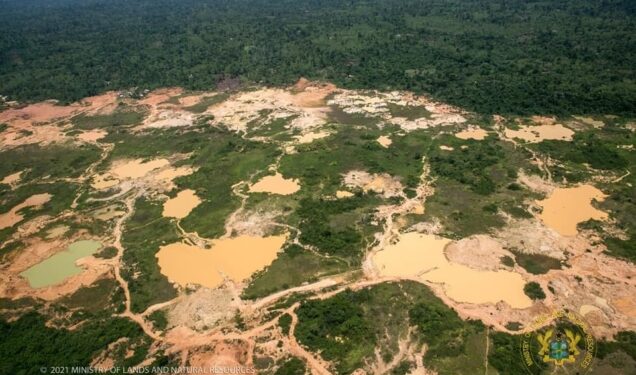US-Based Engineer Questions Scientific Validity of EPA’s River Dechemicalisation Programme
A United States-based professional engineer, Dr. Juliet Ohemeng-Ntiamoah, has cast serious doubt on Ghana’s proposed river dechemicalisation programme, warning that the initiative risks becoming another costly procurement misadventure if implemented without scientific rigour and transparency.
The Environmental Protection Agency (EPA) recently announced plans to deploy copper-based nanoparticles to cleanse rivers heavily polluted by illegal mining activities, a process it claims will neutralise heavy metals and restore aquatic ecosystems.
However, Dr. Ohemeng-Ntiamoah, who specialises in water treatment systems, has described the plan as “scientifically unsound, environmentally risky, and operationally impractical.”
EPA’s Proposed Approach Under Scrutiny
According to the Executive Director of the EPA, Professor Nana Ama Browne Klutse, the agency reviewed several proposals before selecting nano liquids — particularly copper-based nanoparticles — as the preferred method for in-situ treatment of contaminated water bodies.
The technology, she explained, will be applied directly into affected rivers to remove toxins and improve water quality across entire basins.
But Dr. Ohemeng-Ntiamoah has challenged the scientific and operational foundations of this approach.
“River-wide dosing does not meet the required conditions for safe or sustainable water treatment,” she said, questioning whether the EPA had conducted a comprehensive alternatives analysis before settling on the method.
She further called for public disclosure on key technical and procurement issues:
- The availability and long-term supply of the proposed chemicals.
- Operational and maintenance cost assessments.
- The maturity and scalability of the technology in real-world conditions.
- Residual impacts of prolonged chemical dosing on ecosystems.
“These questions must be answered transparently before Ghana commits scarce public resources to such an experimental scheme,” she cautioned.
Laboratory Tests vs Real-World Conditions
Dr. Ohemeng-Ntiamoah criticised the EPA’s reported reliance on laboratory results to justify the proposed technology, describing it as “overly simplistic and potentially misleading.”
She explained that while laboratory trials may yield promising results under controlled conditions, river systems are dynamic, with fluctuating flows, varying pH levels, and diverse biological interactions that can significantly alter treatment outcomes.
“Anyone can add a coagulant to a river water sample in the lab, centrifuge it, and obtain clear water. But that does not mean we can continuously dose chemicals into flowing rivers and expect the same outcome,” she stressed.
Citing international examples, she recalled a US municipality that lost millions of dollars after a treatment process effective in a drinking water plant failed in wastewater applications due to pH variations. Similarly, microbial fuel cells, though promising for decades, remain unfeasible at scale.
Scaling Challenges and Environmental Risks
The engineer warned that scaling laboratory models to entire river systems such as the Ankobra or Pra is fraught with challenges.
“In a lab, dosing 10 milligrams of a chemical into a 100 mL sample may appear effective. But in a river, a single rainfall event could double the river’s volume, instantly diluting the chemical and rendering it useless,” she explained.
She noted that the sheer quantity of chemicals required would make the project prohibitively expensive and logistically complex, while the environmental consequences of continuous chemical introduction remain poorly understood.
“It is neither practical nor sustainable. Without addressing ongoing discharges from illegal mining upstream, any cleanup will be short-lived and ineffective,” she warned.
The Futility of Cleaning Rivers Amid Ongoing Galamsey
Dr. Ohemeng-Ntiamoah maintained that attempting to chemically clean rivers while illegal mining — or galamsey — persists is fundamentally flawed.
“How will this method control stormwater runoff from surrounding mining sites or continuous galamsey effluent? Until illegal mining is eliminated, chemical dosing is like pouring water into a basket,” she remarked.
According to her, heavy metal removal technologies are effective only for point-source discharges where flow and contamination levels are measurable, not for vast, uncontrolled natural systems.
Alternative Pathways to River Restoration
Instead of pursuing a large-scale dechemicalisation scheme, Dr. Ohemeng-Ntiamoah proposed a three-pronged strategy focused on sustainable, science-based interventions:
1. Upgrade existing water treatment plants with proven heavy metal removal technologies to ensure safe drinking water supply.
2. Strengthen enforcement of mining regulations to curb illegal mining, the root cause of river contamination.
3. Restore riparian buffers through tree and shrub planting to naturally absorb pollutants and support long-term ecosystem recovery.
“These solutions are not only cost-effective but also sustainable,” she said. “If we remove the sources of pollution and strengthen our treatment facilities, natural processes like dilution and sedimentation will gradually restore our rivers.”
Dr. Ohemeng-Ntiamoah’s critique comes amid declining public confidence in environmental management, following years of degradation caused by galamsey and weak institutional enforcement.
Her comments underscore growing calls for greater transparency, scientific validation, and fiscal accountability in Ghana’s
environmental interventions — particularly those involving emerging and untested technologies.








